Update, Sept. 22, 2021: Microsoft held its 2021 Surface event on Sept. 22, and unveiled the Surface Duo 2. The new folding phone features a faster processor, better cameras and many other upgrades compared to the Surface Duo.
Product reviews are weird in 2020, and no device I’ve seen this year has been weirder than the Microsoft Surface Duo. Microsoft’s return to phones takes the form of a dual-screen, hinged, foldable Android device that looks like two tiny iPads bonded together. Its two 5.6-inch OLED screens form an 8.1-inch display, bound together by a unique hinge that Microsoft says has been in the works for years. It’s 9.9 millimeters thick when closed, 4.8mm when open, weighs 8.8 ounces (250 grams) and costs $1,200 for the starting configuration, with 128GB of storage. International prices aren’t yet available, but $1,200 converts to about £920 or AU$1,700.
Read more: Unboxing Microsoft’s Surface Duo: Here’s what comes with the dual-screen phone
See it at Best Buy
I’ve been skeptical about dual-screen devices, and I wasn’t sure how I’d feel about the Surface Duo. Wannabe version of Samsung’s possibly even more expensive Galaxy Z Fold 2? (Here’s how the Surface Duo compares to the Galaxy Z Fold 2 and Motorola Razr.) Weird tiny dual-screened version of the Microsoft Surface tablet? Something more?
Inside a little white box in front of me is a gadget that looks like a little book. The Microsoft Windows logo is embossed on top. I open it, bending it a few times. I feel like I’m holding a small Moleskine notebook, made of glass and metal. Inside? No displays. Just circuitry through glass. This isn’t a working version of the Microsoft Surface Duo being unveiled today. This is a special see-through prototype sent to me in advance just so I can see the circuits and feel how the hinge works.
I haven’t had a chance to use an actual working device yet. Instead, I got this specially made, see-through prototype. Kind of ridiculous. And yet, even holding it, I’m already falling in love with the feel of the thing.
This feeling isn’t new.
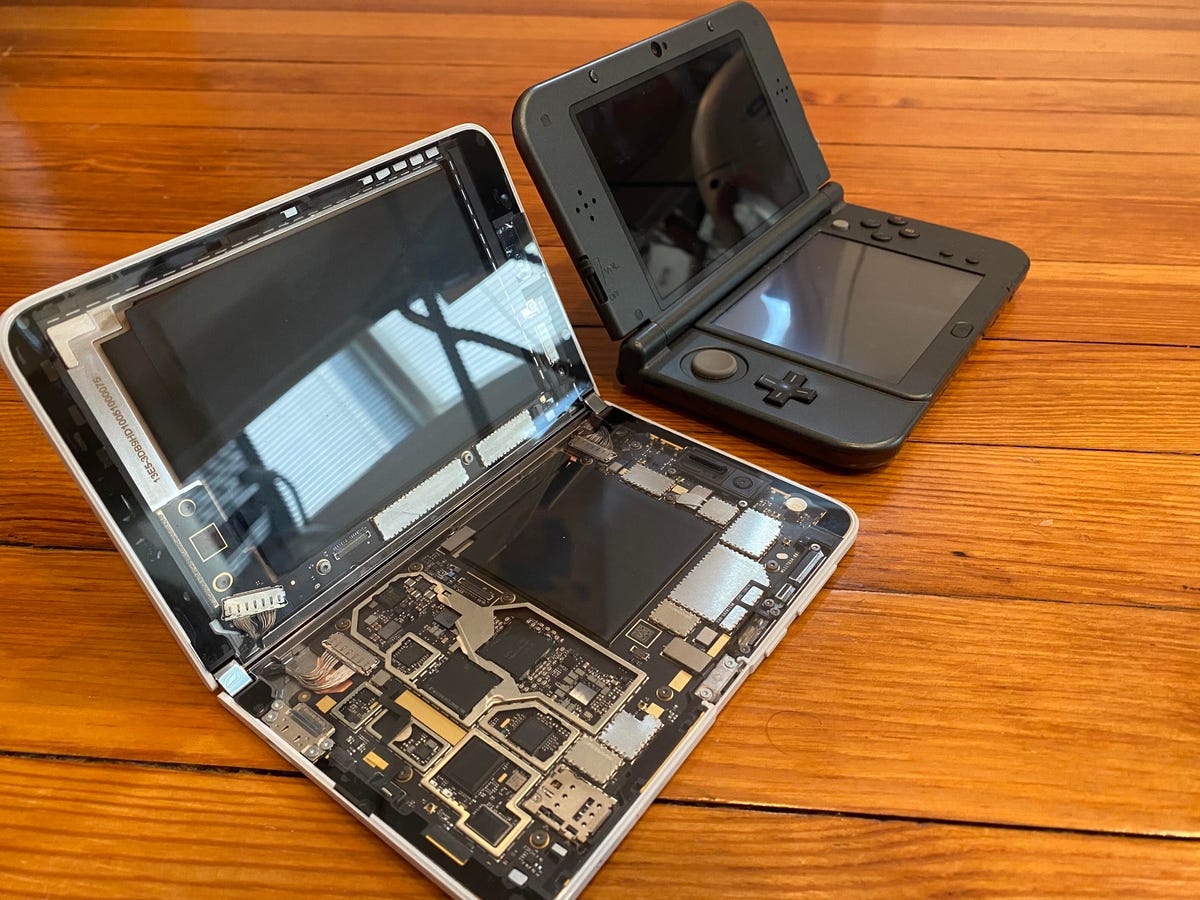

The see-through Surface Duo next to a Nintendo 3DS XL, a dual-screen device my family has used a lot.
Scott Stein/CNET
I’ve been wrong on dual-screen devices before
Back in 2004, I remember opening up an absurd two-screen device that I felt was sure to fail. It had a stylus. It promised twice the viewing area for whole new experiences. I thought it was insane. It was the Nintendo DS, and I soon realized it was a lot more amazing than I expected.
I think about that Nintendo DS whenever I see a product with dual screens or folding screens. But I think about it the most when holding a nonworking shell of the Surface Duo for the first time. I’ve seen the Galaxy Fold, and the Moto Razr, and all the other dual-screen laptops and tablets that seem to be sprouting up like weeds. The Duo seems a lot more like a Nintendo DS or some sort of magic Moleskine. It’s tiny. But not that tiny. It depends on whether you’re perceiving it as a tablet, a phone or a funky digital book.
Microsoft promised to reinvent the idea of dual-screen computing with the Surface Duo and Neo a year ago. The Surface Neo, which will boast two 9-inch screens, has been delayed until 2021. But the Duo is arriving in a few weeks, sooner than expected, maybe right alongside Samsung’s new Galaxy Fold update, in the middle of a pandemic year where everyone’s budget has collapsed and their need for gadgets has become a lot more practical.
The Duo is a phone, but Microsoft clearly doesn’t want to call it a phone. Maybe what Panos Panay, head of Microsoft’s devices business, told me and CNET editor Ian Sherr last week will turn out to be true. Maybe it really is a new device category.
Inside the Microsoft Surface Duo


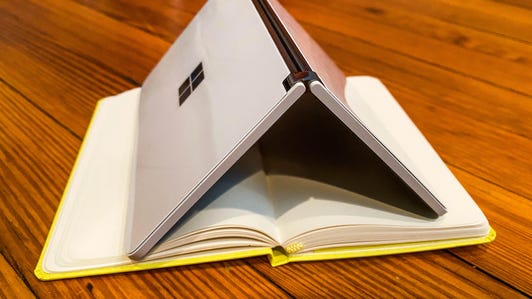

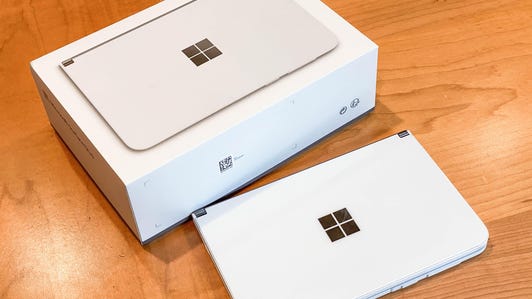

Skeptical? Heck yes
I told my kids I was going to review a dual-screened, phone-slash-tablet thing from Microsoft. My oldest son looked at the folding nonworking device and said, “That’s weird.” But my youngest son was totally into it. “Whoa, does that mean you can play two games at the same time?”
My oldest son says his younger brother is an optimist while he’s more of a realist. It’s also interesting to hear how two kids who never saw a dual-screen thing besides the Nintendo 3DS react to the idea in the first place.
More Duo
- Microsoft Surface Duo’s design is winning me over, even without turning it on
- Microsoft’s Surface Duo phone is powered by Google’s Android, and that’s a big deal
- Microsoft Surface Duo begins preorders starting at $1,399 for 128GB, available Sept 10
- Surface Duo vs Galaxy Z Fold 2 vs Razr: How Microsoft’s new foldable compares to its bendy rivals
Microsoft’s goal, here, is clearly to make the whole idea make sense from a multitasking perspective, helping to solve problems on phones that are already overburdened. I’ll say this much: Being stuck at home on infinite Zooms while trying to work has made me more aware of the need for multidisplays than ever before.
Here’s what Microsoft’s proposition could mean for transforming the foldable device space — a space that clearly hasn’t taken hold yet, but which Google, Microsoft and a lot of other companies are trying to compete in, using physical folding devices and even wearable virtual ones. Will an extra screen solve Microsoft’s phone problems, or will it evolve phones into something many people might not even need? Or is Microsoft’s work on functioning, practical dual-screen apps the sort of necessary work these devices needed in the first place?
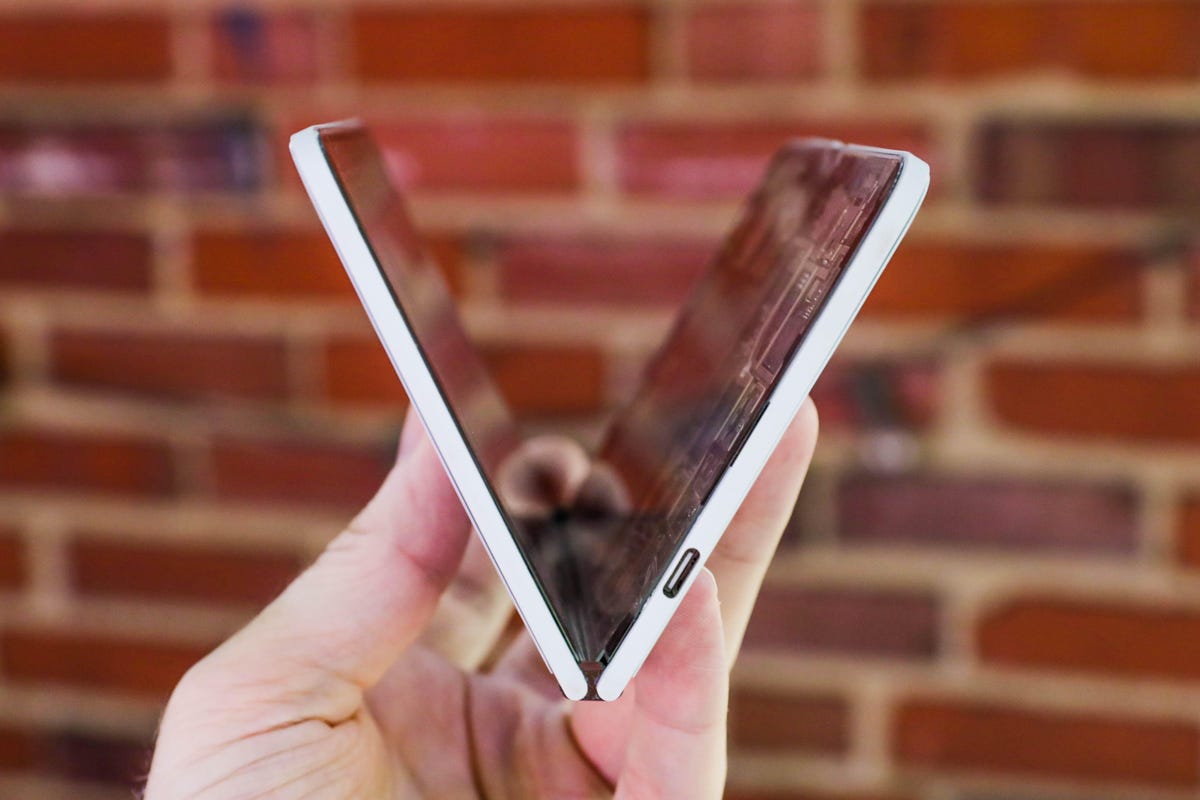

The Duo feels great to hold, even without screens.
Richard Peterson/CNET
2 screens: Are they better than 1?
“As it turns out, it might feel familiar, because there’s this thing, it’s called Windows,” Panay says about using the two-screened Duo. “The idea where I can now formally put two windows next to each other.” That’s what the Duo experience should be, according to Panay: familiar, not strange. Or that’s the hope.
Of course, the Surface Duo is running Google’s Android software, not Windows.
I listen to this over a Microsoft Teams interview done remotely, where I also get a tour of a showroom inside Microsoft’s Building 87 — the same building where the Microsoft HoloLens was developed, and which I visited in person a year ago.
Microsoft’s Duo team operates from research that says two screens are more productive than one, so Microsoft treats the dual screens like a portable pair of monitors. But that’s been the pitch we’ve heard from every other dual-screen phone- and tablet-maker. Microsoft’s angle is aiming to get those screens looking as work-friendly as possible, and make the whole thing feel easy and comfortable to use. The displays are separate rather than folding. That’s to allow for more durable glass and to work with Microsoft Pen without denting the screen, according to Microsoft Technical Fellow Steven Bathiche.
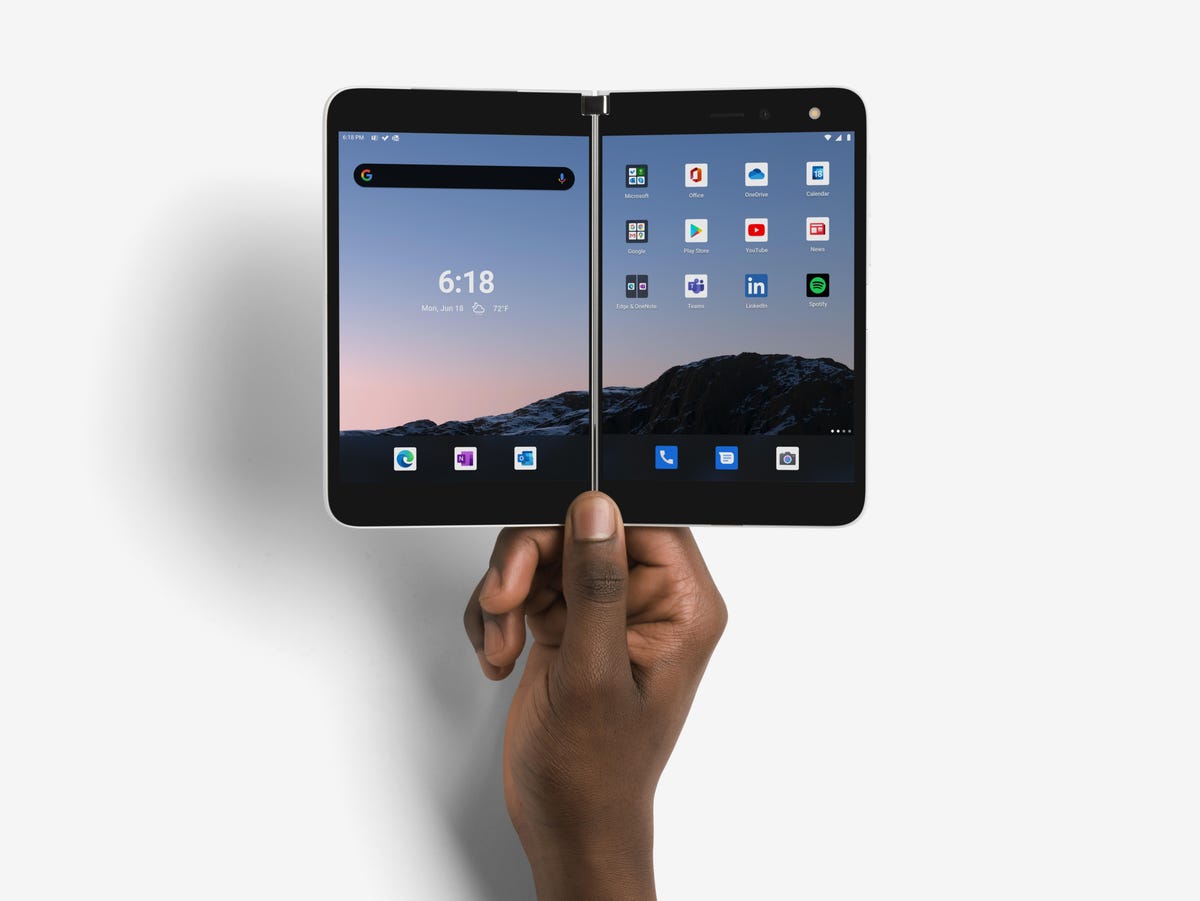

The two 4:3 displays have some significant top and bottom bezels.
Microsoft
The 4:3 aspect ratio on the two 5.6-inch OLED displays is meant to handle the work-friendly part. The idea is to make web pages and documents look readable without weird reformatting, and compare to the same work being done on a laptop or tablet.
The two 5.6-inch displays combine for an effective 8.1 inches — I say effective because those two displays are still split by a little seam in the middle. Panay says that size is amazing for web browsing, but the clear seam in the middle means it won’t be ideal for big videos, necessarily. For that reason, viewing big movies isn’t part of Microsoft’s Duo pitch, although looking at videos on one screen while doing something on the other definitely is.
One thing I find interesting about Duo is that it can stand up easily at a ton of angles: At least, the nonworking model I held in my hands does. It feels like a device I might use to watch something on in one screen and take notes on in another. Again, kind of 3DS-like. But that really depends whether the final product feels useful or awkward.
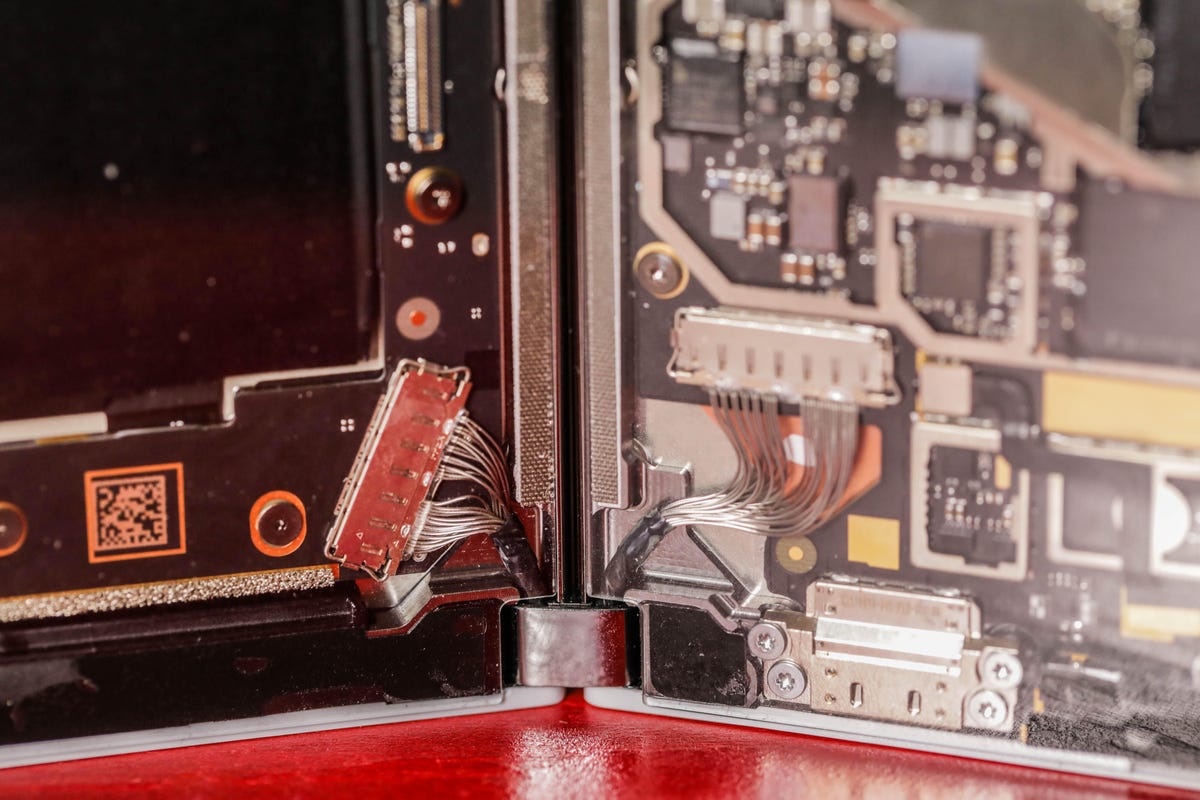

Each half of the Duo has an accelerometer, gyroscope and proximity sensor to sense position and hand apps off from screen to screen.
Richard Peterson/CNET
Apps will work, but not all be dual-screen optimized
Microsoft’s core productivity apps — including Outlook, Word and OneNote — work in dual-display modes and can recognize each other to allow information to be easily thrown between apps. That’s similar to the sort of drag-and-drop ideas that are being worked into the iPad’s dual-app multitasking modes. But other Android apps won’t immediately get that extra level of detail.
Google’s core apps, which include Gmail and Drive, will hopefully be optimized for the Duo soon, but it’s unclear when. A few other third party apps are being courted to make Duo-optimized dual-screen Android versions, most notably Amazon’s Kindle app, which will have two-page reading. “The reading experience is crazy,” Panay boasts. “It’s like picking up a book — you turn a page, it goes from the right to the left, and you just fall into it. You fall in love.”
How many others app-makers will come aboard? That’s the challenge with a new form and an operating system Microsoft didn’t even create. The Duo, running Android 10, is a sort of living concept car for future dual-screen apps and devices.
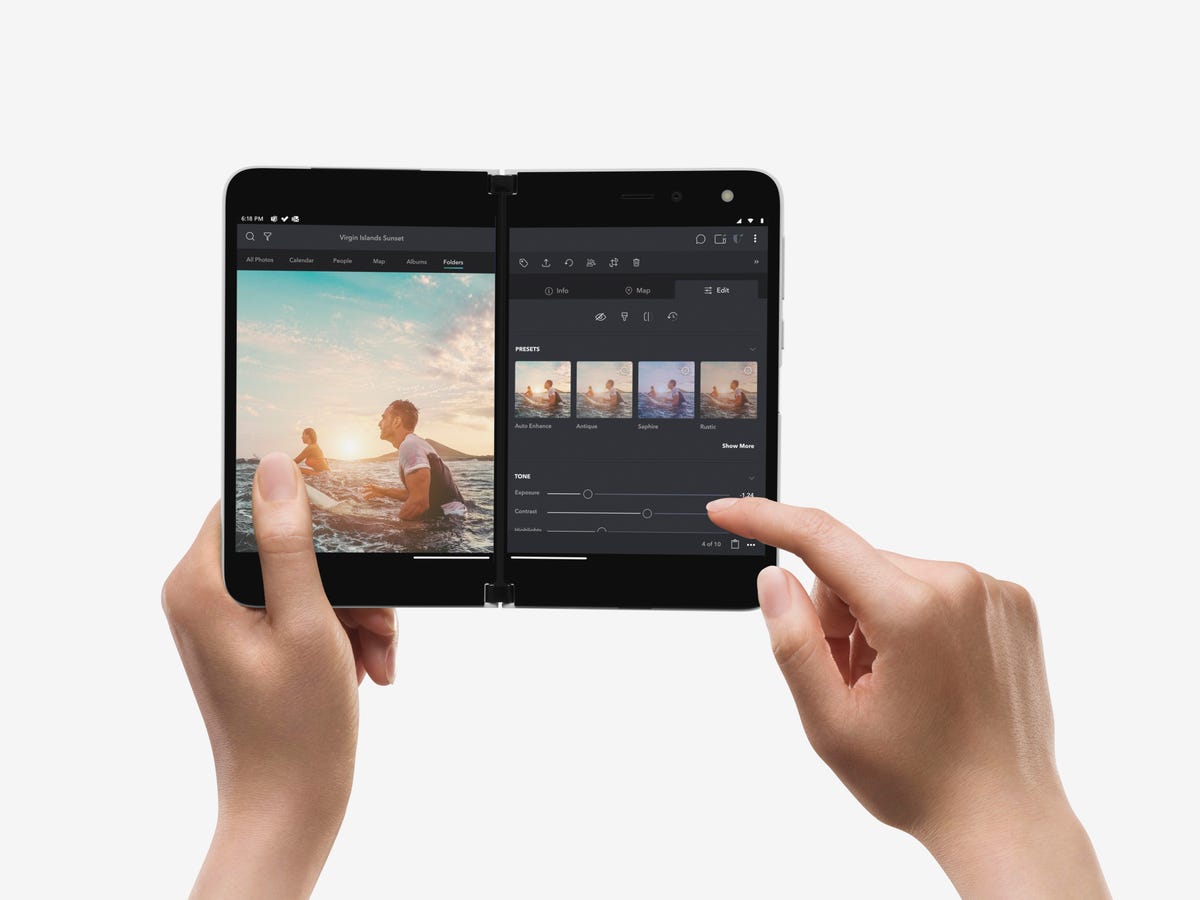

It’s unclear how many apps will optimize to use both displays (seen here).
Microsoft
The dual-screen ideas and the way Microsoft handles them in apps will influence where the Surface Neo goes next year. And it may affect what future devices choose to focus on, too. “When we construct those [dual-screen] APIs for developers, we don’t just want them on Duo,” Panay says. “When dual screens come, even on folding screens, we want those APIs to flow into Android so developers can build for every dual-screen phone.”
It’s unclear, though, whether Google’s plans for dual-screened devices will be in sync with Microsoft’s, or if this is a momentary marriage of convenience before the relatively small group of dual-screened and folding phones maybe expands to a larger scale next year.
“I can’t tell you what Google’s working on,” Panay adds, “But I do believe that if companies want to pick up dual-screen or move forward, we’re setting groundwork foundationally for applications to expand, to rotate the right way, to span those screens to use both screens.”
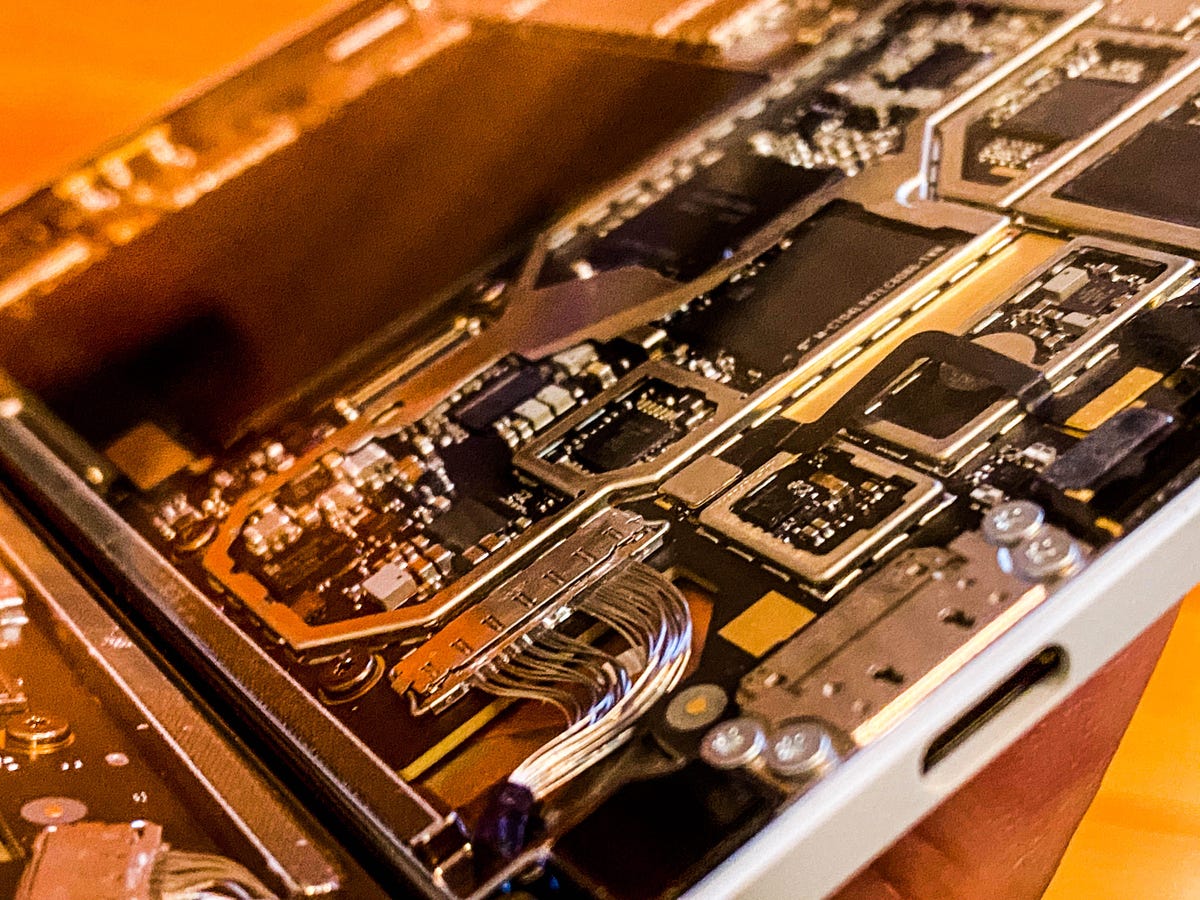

There’s a lot of stuff under the hood in a really thin design on the Surface Duo. There’s a split battery and custom processors, but no 5G.
Scott Stein/CNET
No 5G, large bezels: Sacrifices to get to size
I also get a clear message from Microsoft that size, for the Surface Duo, has been everything. Getting the Duo to a comfy and compact form has meant leaving some features off. There’s no 5G or Wi-Fi 6, because according to Pavan Davaluri, a 16-year Microsoft veteran and Surface engineer we spoke to, the battery performance isn’t currently there for the size of the Duo. “There’s some fundamental things in 5G that would have to come to life to be able to fit into a 4.8mm design,” Davaluri says. “That kind of tech is not there yet. It’s something we’re actively working on.”
Similarly, the larger bezels on the top and bottom of the Surface Duo displays, which clearly aren’t as edge-to-edge as other phones, don’t seem ideal either. It’s less screen real estate for the size. Davaluri admits this was part of a compromise to fit the Duo’s battery and components into such a thin design. Microsoft focused on display quality, hinge mechanisms, device size and battery life over bezels and 5G. “Bezel optimization and 5G, for example, in the grand scheme, I think are solvable problems,” Davaluri adds.
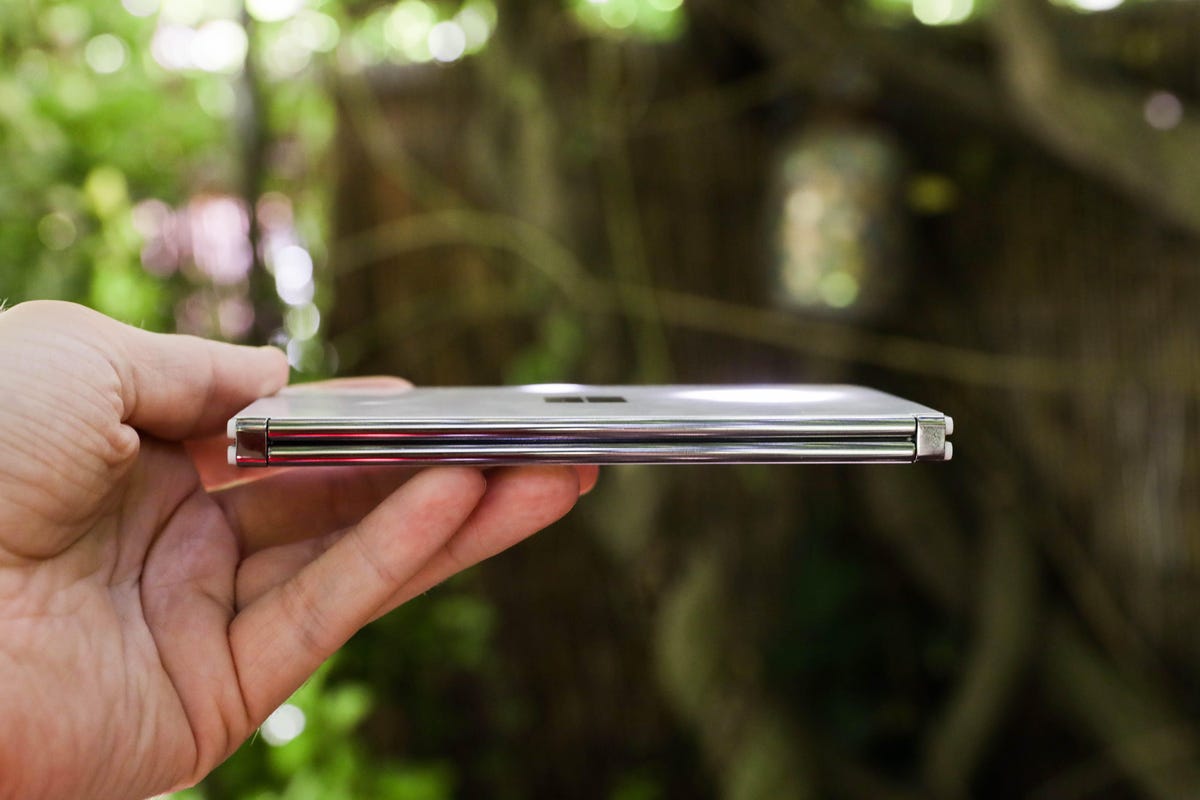

Thinnest dual-screen folding device we’ve seen? Maybe.
Richard Peterson/CNET
The Surface Duo really does feel thin. The nonworking device I held is thinner, when opened, than an iPhone 11 Pro, which is 0.32 inches (8.1mm). Closed, it’s thicker, but it doesn’t feel nearly as bulky as a folded-up Samsung Galaxy Fold, which is 17.1mm thick when closed. And it doesn’t feel like two phones glued together, either. It’s more book-like in its dimensions.
The all-glass front and back of the Duo look sharp, but the design was chosen to improve antenna reception. Will the Duo be durable enough? The device uses Corning’s Gorilla Glass 5 all over, but Microsoft wouldn’t give any claims on drop test reliability. And as for the smooth, sturdy-feeling dual hinges, we’re told to expect “years” of use, but not a specific number of folds it can survive. “The Surface Duo hinge is designed and tested to function well beyond the lifespan of the product,” Microsoft promises us.
It better be good, and it better last, because a device like this isn’t cheap. Starting at $1,399, it’s not far off from other premium phones — and more approachable than the Galaxy Fold was at $2,000. But it’s a lot of money in a world where you could also buy a phone and laptop combined for considerably less.
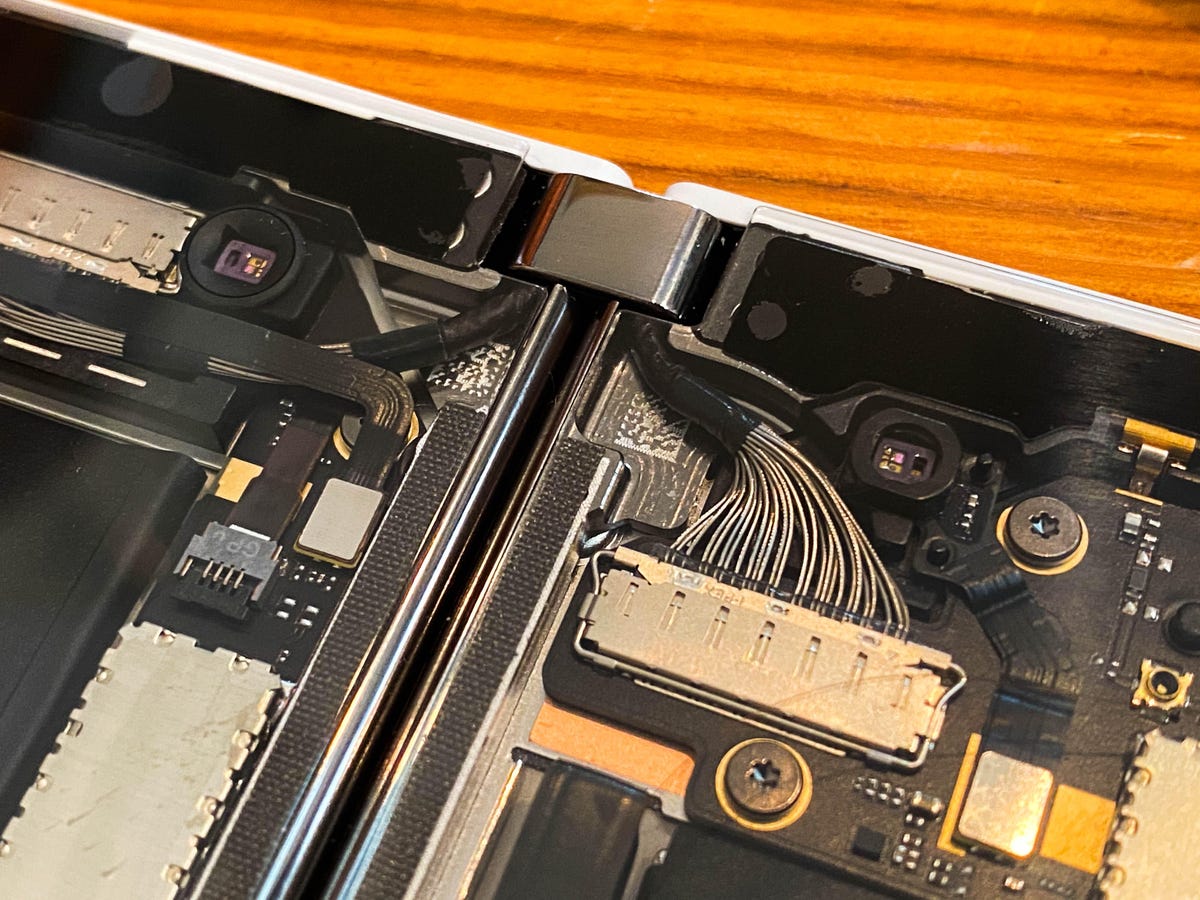

There are a lot of wires running through those hinges.
Scott Stein/CNET
2 screens, but just 1 camera
The Surface Duo doesn’t seem to be about its camera, which is a surprise when just about every other phone has many of them. There’s a single 11-megapixel camera on the inside, which can become an external camera if the Duo displays are flipped around. The f2.0 camera has some AI and a portrait mode, and can shoot 4K video at 30 and 60fps with HDR and slow-motion video. It doesn’t have optical image stabilization or any of the other step-up zoom and focus features you find in other phones.
I don’t know what the camera will be like, but Microsoft is clearly downplaying it as a core feature on the Surface Duo. And in a world that’s more camera-focused than ever, that seems like weird timing.
CNET
A specific tool in the toolbox
Microsoft isn’t going for a one-gadget-that-does-everything approach here. Instead it suggests that this is a device that will suit some, but it’s not necessarily for everyone. The idea of specialized gadgets isn’t new: Our lives are already flooded with smart speakers, smartwatches, modular game consoles and tablets that often slide somewhere between phones and laptops.
Panay seemed hesitant to call the Duo a new device category, because it really isn’t. It’s an Android phone. Or, a tablet. “It really is five years of invention … we just have a belief that there’s a new category here,” Panay adds.
Microsoft’s argument makes sense, though, especially as a software developer who lives among devices ranging from iPads to game consoles to VR headsets. I’m reminded, holding the Surface Duo, of the first wearables before smartwatches became a thing, or the first smartphones before the iPhone, or early VR headsets before Oculus. Dual screen devices need to nail down their identity, still.
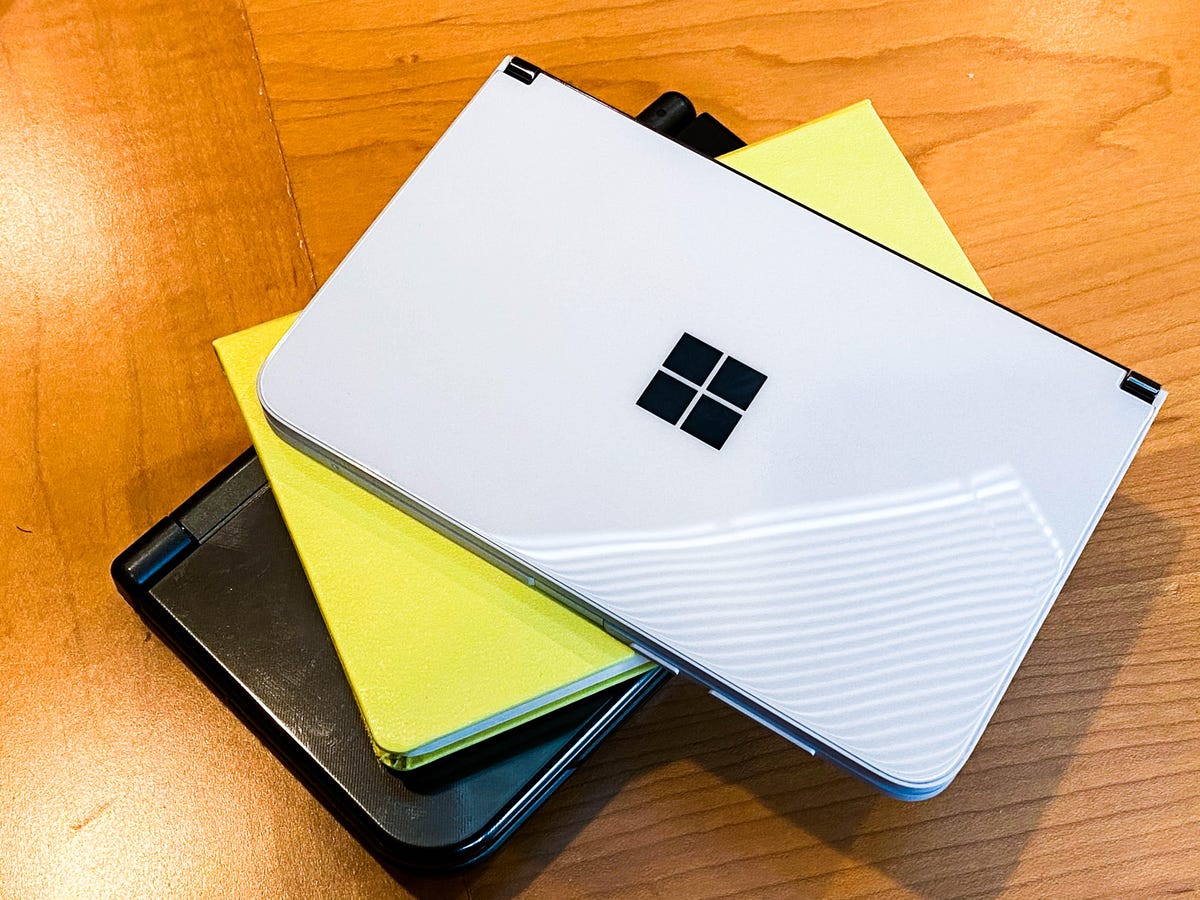

Notebook, game console, phone, PC: how will the Duo be perceived and used?
Scott Stein/CNET
I also wonder: In a world where screens may be everywhere and increasingly virtual through VR and AR headsets and glasses (or TVs and displays that can sync seamlessly with your phone), what is the purpose of a dual-screen pocket device?
Steven Bathiche, a Microsoft Technical Fellow who heads the Applied Sciences Group, has a farther-ranging view of where devices like Surface Duo fit. “Everything is the best for something and the worst for something else,” he told me from a space that looked like his home.
“I see a world where we’ll just have more and more fundamentally specialized tools to help you get stuff done,” Bathiche says. “But they’re going to be connected by software and through the cloud to make them feel like they work as one.”
For a company that also pushes into expensive professional tools such as Microsoft’s $3,500 HoloLens mixed reality headset, it’s unclear which customers will be first to pick up a Surface Duo. But as a concept car to test-drive apps and build out a road where other devices will follow, it makes perfect sense. I just don’t know, yet, if I’m going to want to hop aboard.



